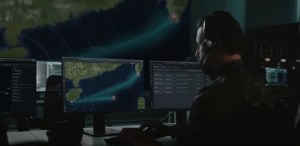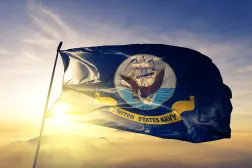Navy’s new ‘economic deterrence’ council aims to protect high-tech vendors from adversaries

At the direction of Secretary of the Navy Carlos Del Toro, the sea service earlier this month stood up a new Maritime Economic Deterrence Executive Council to help protect commercial companies and other vendors from adversaries who seek to take advantage of them.
The move comes as the Navy and Marine Corps are increasingly looking to commercial providers and other nontraditional suppliers in Silicon Valley and other regions for high-tech capabilities like artificial intelligence, autonomous systems and maritime drones.
“Our potential adversaries are indeed pursuing courses of actions that go beyond leveraging their military might, to include the exploitation of the investment industry and innovation ecosystems that serve as the engine of the economies the United States, our allies and our international partners, exploiting supply chain vulnerabilities, adversarial capital investments in companies developing technologies that are critical to our fleet and our force, as well as the intellectual property theft that is ongoing by so many concerted actions [are] designed to weaken our competitive advantages, not only at sea, but on the world’s economic stage. And this has much impact on the U.S. economy,” Del Toro said Thursday at an event hosted by the Aspen Strategy Group at Bloomberg headquarters in New York.
The council will be co-chaired by Vice Adm. Francis Morley, the principal military deputy to the assistant secretary of the Navy for research, development and acquisition and Chris Diaz, the SECNAV’s chief of staff. It will include other representatives from the R&D and acquisition communities, intelligence and law enforcement, and supply chain and critical infrastructure subject matter experts.
“This brings together several commands that are already focused on countering adversarial economic activities that directly impact our Navy and our Marine Corps,” Del Toro said.
The council, dubbed MEDEC, is empowered to act via authorities already granted to the Department of the Navy, according to Del Toro.
The group’s focus will be on mitigating adversarial foreign investment risks, guarding innovations, supply chain integrity initiatives, and protecting research efforts across both the government and private sector.
“While the work to protect our defense industrial ecosystem by each organization is not new, bringing them together as a unified, focused council to address maritime economic deterrence allows us to better synchronize our efforts and be leaders in a larger DOD economic deterrence initiative. The work of MEDEC is more than just preserving military advantages for our sailors and Marines. We are undertaking these initiatives to better support you, our business partners, and our investment communities that we rely on to design, test and build the technologies and capabilities that we will adopt and field in the future,” Del Toro said.
The commercial sector is driving many of the technology advancements that the Navy wants to tap into for next-generation platforms and capabilities, such as unmanned systems and advanced algorithms. Some of those companies are small or medium-sized businesses that might be especially vulnerable to adversarial activity.
Rapid developments in high-tech against a backdrop of great power competition with nations such as China, is driving the Navy and Marine Corps to think differently about how they operate and rapidly acquire new capabilities.
“Those set of circumstances give us a very porous environment. And so we have to work with all of you in order to ensure that we’re on the same page as far as where the risk investment dollars are, how we protect, how we set the foundations for the technology protection early on — but at the same time do it smartly so we don’t construct barriers of entry that are prohibitive to a lot of small business and tech companies that are really going to drive some of that,” Morley told members of industry at Thursday’s event.
The Navy and Marine Corps already have “a thousand” AI-related projects, Del Toro said, and the technology is expected to transform how the department does business.
The sea services have been experimenting with various types of drones, artificial intelligence capabilities and related technologies in multiple theaters, including 5th Fleet in the Middle East, 4th Fleet in Central and South America, and 3rd and 7th Fleets in the Indo-Pacific. And plans call for integrating more of them into the force as the Navy pursues a so-called “hybrid fleet” of crewed and uncrewed platforms.
The SECNAV suggested that investors can help keep more innovators afloat in the Navy’s ecosystem.
“I really want the private sector to take a hard look at what are our requirements, obviously, but take a look at all the small and medium-sized businesses and even large businesses that are actually coming to the table to meet those requirements. There’s a lot of innovation going on. There’s a lot of small tech companies out there are just coming up with great ideas that are asymmetrical solutions to the threats that we face, you know, in the Red Sea, in the Pacific and all around the globe. And whether it’s AI and quantum or machine learning and many of these other high-tech portfolios. I think you should take an aggressive look at these small companies and the ideas they’re coming up with and back them up and invest in them so that they have the capital necessary to be able to do work with the government, which we sometimes know is challenging,” he said.
Morley noted that the Navy also needs to bring more cutting-edge tech into large-scale production for the military.
Using relatively low-cost robotic systems from the commercial sector has allowed the service to experiment, take risks, prototype, and sometimes fail without making huge capital investments, he noted.
“We recognize that in the unmanned space we have to understand, learn … right now. [But] we’ve got to start establishing program of record and scale to keep industry in the game and to give us the actual products,” Morley said.
Some technologies, such as artificial intelligence capabilities, will come from lower down in the supply chain, he noted.
“A lot of this tech is tech that’s going to insert at the tier three, tier four supplier [level]. Right? We’re probably not going to directly contract for perhaps an AI algorithm, but we’re going to contract for an airplane that’s got a mission computer that does something that requires an AI algorithm to do. So our ability to inject that tech, either through our primes or other ways — we’ve got some work to do on that,” he said.






